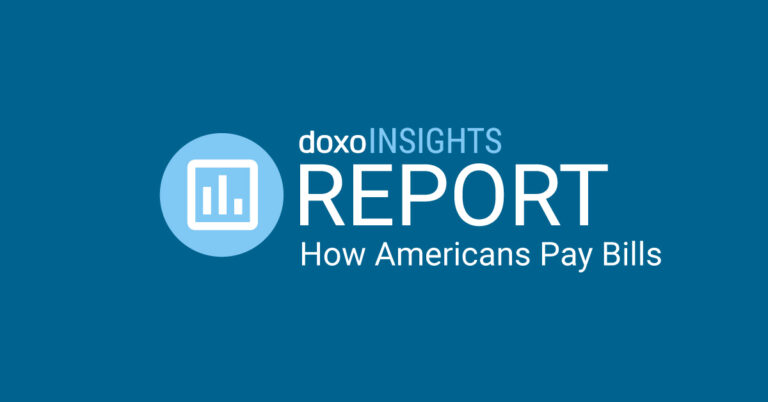Inside the Bill Pay Habits of U.S. Households in 2025

New Report Uncovers How Americans Pay Their Bills — and the Mounting Concerns Behind the $4.55 Trillion Bill Pay Economy
A new doxo 2025 Report: The Bill Pay Economy™: How Americans Pay Their Bills reveals the financial weight, risks, and daily habits behind the household bill pay experience in the U.S. The findings show Americans are spending nearly a third of their income on bills while grappling with rising costs, security concerns, and the stress of keeping up.
Bills Take Up Nearly a Third of Household Income
The report provides in-depth analysis of U.S. bill pay behavior and demographics, revealing that households now spend a median of $24,695 annually—roughly 31% of their income—on the 13 most common bills, including utilities, rent, mortgage, mobile phone, internet, auto loans, and insurance. Altogether, U.S. households pay a total of $4.55 trillion each year on essential bills.
“Bills are the single largest expense category for American households, and our findings show that paying them is not only financially burdensome but also emotionally stressful,” said Steve Shivers, co-founder and CEO at doxo. “From growing fears of fraud to the strain of rising costs, households are looking for better, safer, and more convenient ways to manage payments.”
Inflation and Financial Stress Are Squeezing Families
Households report that inflation and rising costs are making bill pay even more difficult:
- 77% of adults say their financial situation is worse or significantly worse than a year ago.
- Nearly half of households reduced savings or delayed a major purchase to stay current on bills.
- 17% delay at least one bill each month, while 45% could not cover three months of bills from savings if income were lost.
Security and Fees Top Consumer Concerns
Americans are not only worried about making ends meet — they’re also deeply concerned about the risks tied to the bill pay process itself:
- Identity fraud: 84% express concern, with 45% “very concerned.”
- Stolen payment information: 86% express concern.
- Credit impact: 83% worry about the effect on their credit score.
- Fees: 67% fear late fees, while 57% are concerned about overdraft fees.
These concerns are intensifying. 43% of households report being more worried about identity fraud this year than last, compared to 41% who said the same in 2024. This makes identity fraud one of the fastest-rising concerns for bill payers.
How Americans Pay Their Bills
Despite the stress, U.S. households use a wide mix of payment methods and reminders to manage obligations:
- Channels: Biller websites are the most common, followed by bank portals. Mail and in-person payments remain in use for certain bill types.
- Methods: 73% pay mortgages via ACH (direct bank transfer), while 14% still pay rent in cash.
- Reminders: 42% of mobile phone bills are auto-scheduled, but only 9% of rent payments are. By contrast, 26% of water and sewer bills are paid when the paper bill arrives in the mail.
- Timing: Payments peak on weekdays — especially Monday, Tuesday, and Friday mornings.
What Consumers Want
The report highlights a clear desire among Americans for more streamlined, convenient, and secure ways to manage their bills. Consumers are signaling that bill pay solutions must go beyond simple transactions to help reduce stress and improve organization:
- 65% want email reminders to avoid missed payments and late fees.
- 60% want mobile apps or mobile-friendly websites so they can manage bills on the go.
- 55% want all-in-one bill pay platforms that consolidate multiple bills into one secure place, eliminating the hassle of juggling logins and due dates.
- 46% want the ability to use multiple payment methods (bank account, credit, or debit) depending on what works best for their financial situation.
Together, these preferences show that consumers are actively looking for tools that combine security, flexibility, and simplicity — reflecting the growing need for innovations that ease the burden of bill pay.
Emotional Impact of Bill Pay
Paying bills isn’t just a financial task — it’s an emotional experience that affects households differently. The report shows that once bills are paid, Americans experience a mix of relief, satisfaction, and stress:
- 33% feel accomplished, viewing it as checking off a major financial responsibility.
- 27% feel relieved, no longer having the bill hanging over them.
- 26% feel happy or satisfied, experiencing peace of mind from being up to date.
- 14% still feel anxious or stressed, underscoring how bill pay can remain a source of financial tension even after payments are made.
This mix of emotions highlights both the sense of responsibility and pride that comes with staying current, as well as the ongoing stress many households feel due to rising costs, financial instability, and concerns about security.
How Americans Pay Their Bills
This report examines who the bill pay consumer is, and how and when they pay their household bills. When it comes to bill pay practices, the report shows, there is no normal.
